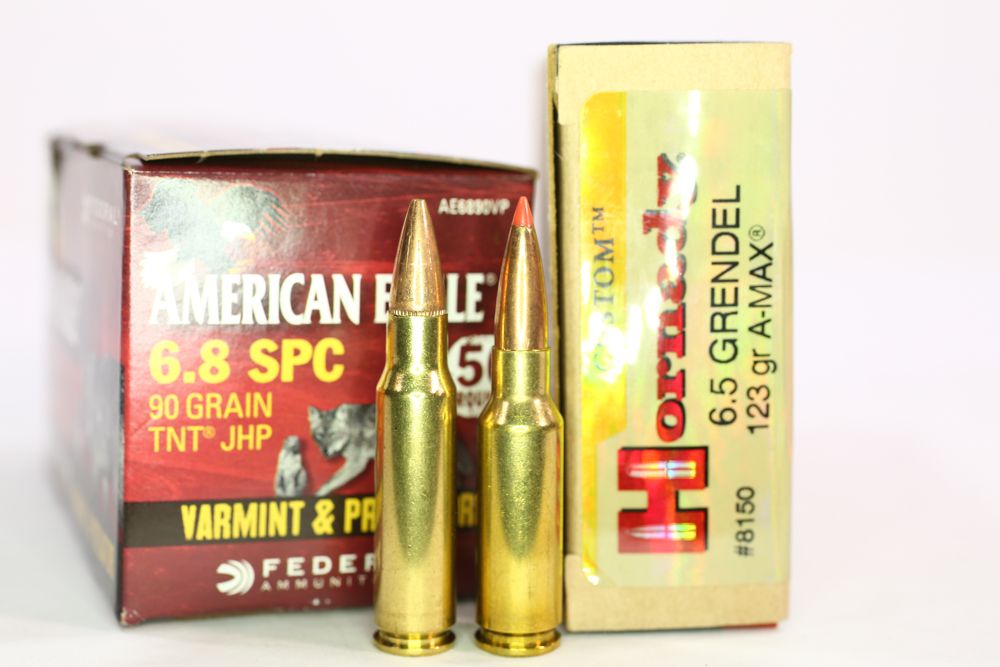When it comes to 6.8 SPC vs 6.5 Grendel, the better intermediate cartridge all depends on your aims.
For most, the .223 Remington/5.56 NATO is enough to get the job done in an AR-15. Hey, it’s fit the bill for the U.S. military for going on 60 years now, so there is proof in the pudding. However, more than one marksman—military and civilian—has yearned for a bit more oomph per trigger pull.
This was especially true in the early years of this century when in-the-field performance issues with the 5.56 reared their ugly heads. The less than desirable results in the hands of our fighting men and women got the innovation wheels turning in search of a solution. The answer: a true-to-form intermediate cartridge, something along the lines of the storied Soviet 7.62×39mm. Medicine that put bad guys down and kept them there.
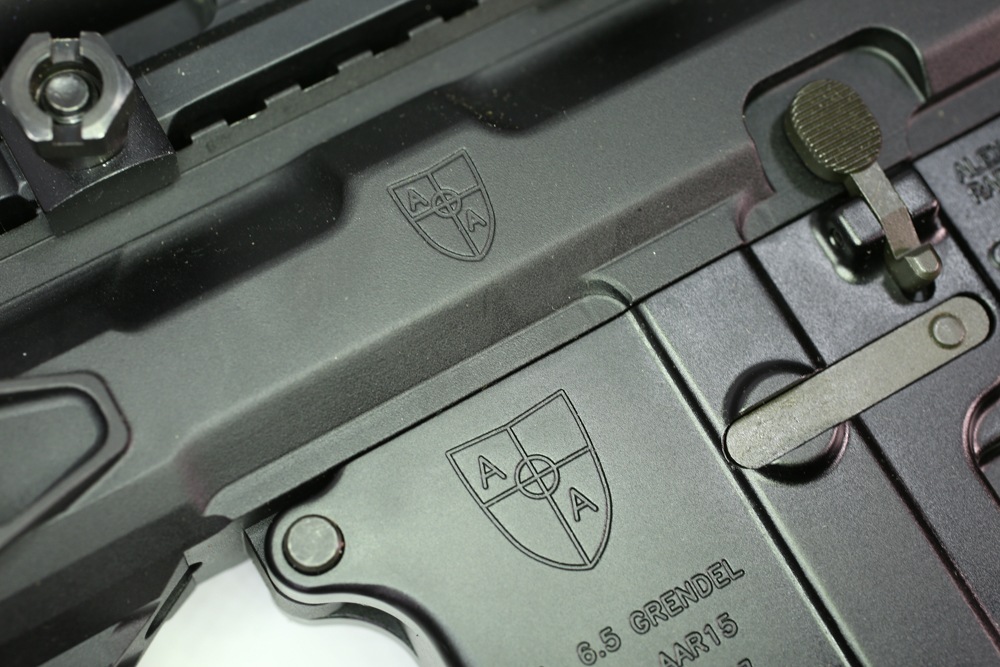
This answer came in two cartridges—the 6.8 SPC and 6.5 Grendel. While not enough to de-throne the small-bore king as head of the military, the metric marvels vastly improved the potential of AR-style rifles with minimal disruption to the rifle’s design. Not a bad combination, one that earned each a dedicated following. That morphed into the mythologies of the hard-hitting 6.8 and the long-flying 6.5.
For many, the 6.8 SPC vs 6.5 Grendel debate seems cut and dry. Except, it’s not quite. Truth be told, there’s a bit of nuance to the conversation.
Shared History
As mentioned, both cartridges were attempts to improve on the 5.56 NATO, in particular the small-bore’s terminal ballistics. The simplest path was to step up the caliber.
In 2004, the 6.8 SPC hit the scene. A multi-year project between Remington Arms and the U.S. Army Marksmanship Unit to develop a more potent intermediate option, the cartridge had some early snags (more on that in a moment). Through testing, the 6.8mm became the choice since it proved as accurate as the 6.5 cartridges at medium range, but offered improved terminal performance, somewhat akin to the 7mm. Remington turned to the defunct .30 Remington—essentially a rimless .30-30 Winchester—for the parent case since it provided ample capacity with a marginally larger case head (.422 inch). While it required a bolt upgrade and dedicated magazines, the slightly larger head size theoretically didn’t inject structural integrity issues.
As to the aforementioned snags, what Remington delivered to the military wasn’t up to snuff—not the cartridge, but the chamber design. Too little lead (.050 inch) led to pressure issues. “Big Green” remedied this with downloaded ammo, but that hurt the cartridge’s performance. Thankfully, the chamber issue has been addressed since, the lead extended to .100 inch in what is known as the 6.8 SPC II. Most modern rifles chambered for the cartridge are of this ilk and say as much on the barrel. Officially, however, the original 6.8 SPC design is still what’s on file with the Shooting Arms and Ammunition Manufacturers’ Institute’s (SAAMI).
The 6.5 Grendel hit the scene in 2003 through the efforts of Bill Alexander (of Alexander Arms) and Janne Pohjoispää. In designing an intermediate cartridge they turned to a logical parent case for the job—the legendary 7.62x39mm (with a nod to its PPC progeny). The Grendel, too, requires a new bolt to accommodate its larger case head (.445) as well as dedicated magazines.
While its designers had military aspirations for the Grendel, it mainly remained a target-shooting and hunting option—at least stateside. In more recent times and in other parts of the world this has changed. In 2016, the Serbian Army become the first military force to officially adopt the cartridge, adding some legitimacy to the design.
Learn More About The 6.8 SPC And 6.5 Grendel:
6.8 SPC Vs 6.5 Grendel Ballistics
There is a lot of hubbub when it comes to debating 6.8 SPC vs 6.5 Grendel ballistics. In most people’s minds, the SPC (Special Purpose Cartridge) is a true intermediate cartridge, while the Grendel flirts with long-range capabilities. However, the cartridges’ external ballistics track much closer than most folks expect.
Much of this is due to nearly identical case capacities. Depending on the brass in question, both hold right around 35-grains of water. Essentially, this means loaded with the same powder, with the same bullet weight, out of barrels of equal length, both cartridges will produce similar velocities. The difference comes in ballistic coefficients, given at the same weight a 6.5 bullet will be longer, thus boast a higher ballistic coefficient (BC). Simply put, it will buck air resistance and wind drift more efficiently. But crunch the numbers and you’ll find Grendel’s downrange advantage takes time to manifest.
An example. Take handloads for the 6.8 SPC and 6.5 Grendel both topped with 120-grain Hornady SST bullets pushed by Ramshot X-Terminator powder for maximum velocity out of a 20-inch barrel. According to the Western Powders Reloading Manual, a shooter can expect the .510 BC (G1 model) Grendel bullet to launch at 2,344 fps and the SPC’s .400 BC bullet at 2,457. Out to 600 yards with a 100-yard zero, the loads track nearly identical trajectories. It’s only after this point that the Grendel performs better, dropping 6-inches less at 700 yards and 10-inches less at 800 yards. Additionally, while the 6.8 goes sub-sonic—thus losing optimal ballistic performance—just past 800 yards, the 6.5 stays supersonic out to nearly 1,000 yards.
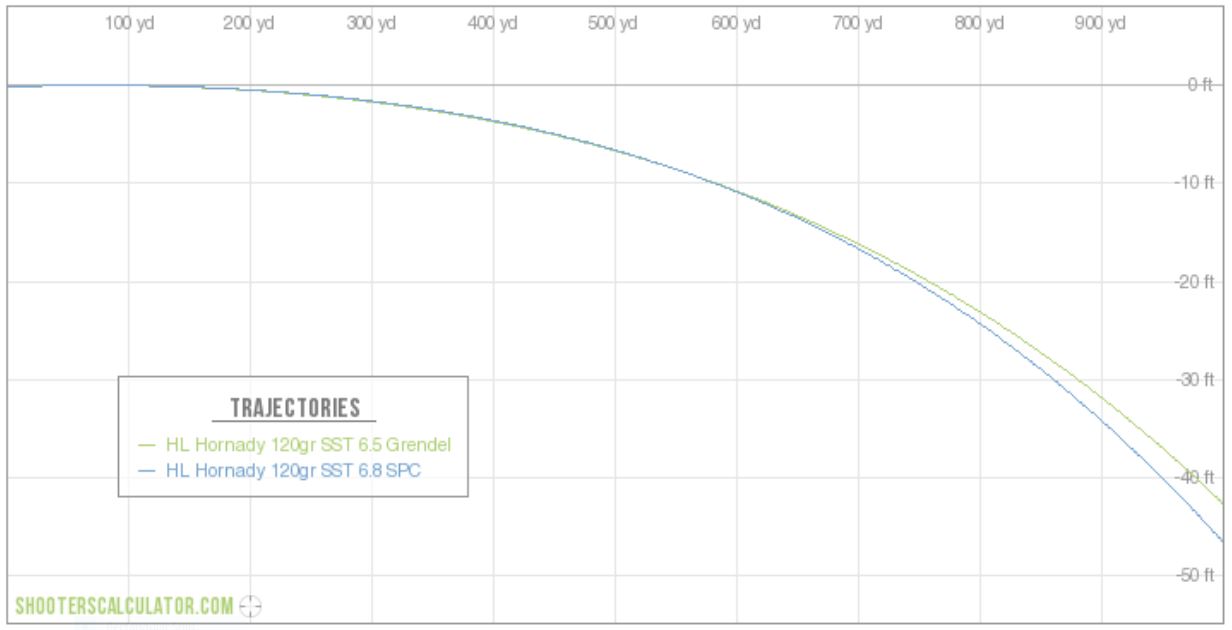
This is a sterilized example and not quite true to life. While there are ample specimens of 20-inch 6.5 Grendel rifles, they’re rarer for the 6.8 SPC, which is found in carbine-length guns and smaller. Let’s look at another scenario, a more realistic one that takes this into account.
Take two similar factory loads, heaviest for caliber in Hornady’s Custom line: a 123-grain SST bullet (.510 BC) for the Grendel and a 120-grain SST bullet (.400 BC) in the 6.8 SPC. Next, we’ll put the rounds in much more common configurations for each caliber—a 20-inch barreled rifle Grendel and a 16-inch barreled one for the SPC. In addition to the higher BC, the extra bore in the Grendel gives the rifle/cartridge combination a 120 fps advantage over the SPC. This adds up past the 300-yard mark. Again on a 100-yard zero, at 500 yards the Grendel has fallen 15-inches less than the SPC and at 600 yards 26-inches less. That’s substantial for anyone concerned about flatter trajectories or reaching out.

There are arguments the 6.8 SPC has a superior terminal profile, doing more damage once at its target. Military testing has turned up the 6.8 (or .270 if you will) does tend to produce more devastating wounding patterns. Much of this is attributable to the caliber’s larger diameter, plus a greater cross-section at the nose that more efficiently initiates bullet expansion. Though, hit a whitetail in the vitals at a reasonable hunting range with either 6.8 SPC or 6.5 Grendel, chances are the deer won’t know the difference.
6.8 SPC Vs 6.5 Grendel Platforms
If the 6.5 Grendel allows a longer effective range than the 6.8, it seems it should be the natural choice for most shooters. We’ve foreshadowed why there’s a place for both cartridges in modern shooting, however. Get behind most 6.8 SPC guns and you’ll drive a more nimble platform.
As mentioned, carbine-length rifles (16-inch barrels and down) are the norm for the 6.8, which makes sense given who the cartridge appeals to. Hog hunters have buoyed the SPC thanks to its excellent intermediate performance and agility of its platforms. In places such as Texas and Oklahoma, management of these critters is a target-rich endeavor that calls for a hard-hitting and deft gun/cartridge combination. Furthermore, the 6.8 SPC has found a place in short-barreled rifles and AR-pistols, a very potent defensive option that excels in close-quarters engagements.
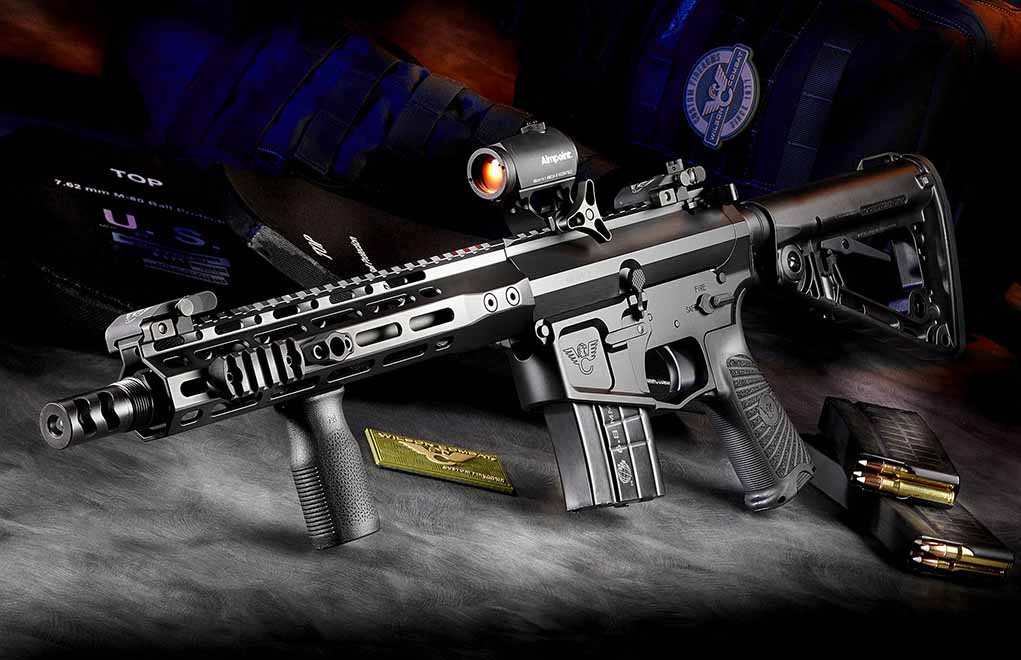
This isn’t to say the 6.5 Grendel isn’t available as a carbine. Heck, Palmetto State Armory has a 12-inch Grendel pistol, for those interested. However, given most folks’ desire to take advantage of the cartridge ballistic capabilities, 20-inch-plus barrels dominate. Even Bill Alexander recommends this length for Grendel rifles aimed at hunting. Certainly, with practice, shooters can become quick in transitioning targets with a longer-barreled gun, but overall it is more challenging.
6.8 SPC Vs 6.5 Grendel Ammo
Since this is early 2021, talking about ammunition selection seems glib. In the present ammo squeeze, you take what you can get. In fatter times, both cartridges are fairly abundant, though there is some difference in what’s stocked on virtual and brick-and-mortar shelves.
Hunting ammunition, topped with soft-point or polymer tipped bullets, dominates the 6.8 SPC selection. This makes sense since it’s been hunters who keep the cartridge afloat. Away from this arena, expect little more than affordable range ammo with FMJ bullets.
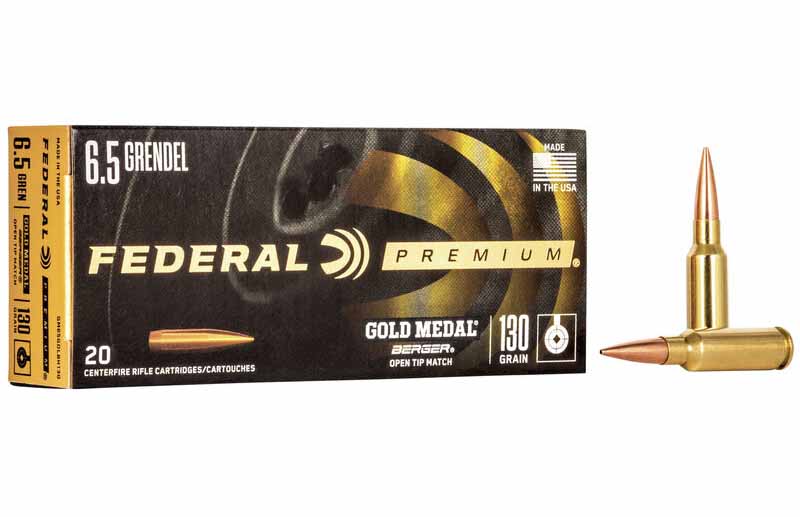
Given it has a more dedicated following of target shooters and technically has the chops to reach out 1,000 yards in skilled hands, the 6.5 Grendel has a wider ammo selection. In addition to hunting and range ammo, manufacturers also turn out legitimate match options. For instance, Federal Premium’s Gold Medal Grendel ammo boasts a 130-grain Berger AR Hybrid OTM bullet—a modern low-drag projectile designed to maximize range.
As far as factory-loaded ammo, expect similar bullet weights for both cartridges; the 6.8 SPC ranging from 85-grains to 140-grains and the 6.5 Grendel 85-grains to 130-grains.
Who Fits Whom?
So, when everything shakes out in the 6.8 SPC vs 6.5 Grendel conversation, which cartridge is the best fit for which shooter? It’s a difficult question to answer. Given when everything is equal, the cartridges have similar performance. But they’re still not identical.
Since the 6.8 SPC is generally found and performs well out of carbine- and pistol-length guns, the cartridge excels at tasks that require agility in the 300-yard neighborhood. That could be thinning a sounder of hogs or pieing a corner to confront a bump in the night. On the flip side, the 6.5 Grendel gives you the ability to stretch your rifle’s legs or hunt in open country. You’ll have to pack more rifle with you, but the effort pays off with a selection of higher BC bullets and the ability to operate out to 800 yards.
Compared to other cartridge comparisons, the differences are slimmer in the 6.8 SPC vs 6.5 Grendel debate. That said, at the margins each provides an advantage to a particular shooter. You just have to puzzle out what shooter you happen to be.
 NEXT STEP: Download Your Free Storm Tactical Printable Target Pack
NEXT STEP: Download Your Free Storm Tactical Printable Target Pack
62 Printable MOA Targets with DOT Drills – Rifle Range in YARDS This impressive target pack from our friends at Storm Tactical contains 62 printable targets for rifle and handgun range use. Target grids and bullseye sizes are in MOA. Ideal for long-range shooting! Get Free Targets
